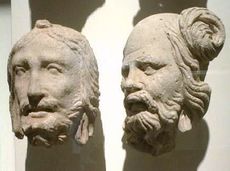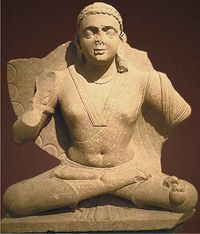غندهارا
- هذه المقالة هي عن المملكة القديمة. للأماكن الأخرى، انظر مدينة گاندارا. گاندارا هي أيضاً اسم مقترح لمقاطعة خيبر پختونخوا في پاكستان. انظر أيضاً گندرا وگندهار.
گندهارا (بالسنسكريتية وبالهندي: गन्धार، بالپنجابي: گندھارا، Pashto: ګندارا؛ أردو: گندھارا، Gandḥārā؛ إنگليزية: Gandhāra؛ بالفارسية: ویهیند) هو اسم المملكة القديمة (مهاجناپادا Mahajanapada)، التي كانت تقع فيما هو الآن شمال پاكستان وشرق أفغانستان. وكانت گاندارا تقع بشكل رئيسي في وادي پشاور، هضبة پوطهوهار (انظر تكسيلا) وعلى نهر كابول. ومدنها الرئيسية كانت پوروشاپورا (پشاور المعاصرة)، وتعني حرفياً "مدينة الإنسان"[1] و تكشاشيلا (تكسيلا المعاصرة).[2]
استمرت مملكة گندهارا من أوائل الألفية الأولى ق.م. حتى القرن 11 الميلادي. وقد بلغت أوج حضارتها من القرن الأول وحتى القرن الخامس تحت ملوك كوشان البوذيين. شاهي الهندوسي، الذي كان مصطلحاً استخدمه المؤرخ البيروني[3] ليشير إلى الأسرة الهندوسية الحاكمة[4] الذين استولوا على الحكم من تركيشاهي وحكموا المنطقة في الفترة السابقة للفتح الإسلامي في القرنين 10 و 11. وبعد أن فتحها محمود الغزنوي في 1021 م، اختفى الاسم گندرا. وأثناء الفترة الإسلامية أصبحت المنطقة تدار من لاهور أو من كابول. وفي العصر المغل صارت المنطقة جزءاً من مقاطعة كابول.
الجغرافيا

.
تقع غاندارا Gandhara في شمال غربي الهند. وكانت تضم أجزاء من بلاد أفغانستان وباكستان، وفيها أدى امتزاج الثقافتين الهندية واليونانية إلى ولادة الفن «اليوناني-البوذي» في پـِشاور الباكستانية أولاً بين منتصف القرن الأول والقرن الثالث الميلاديين، لينتشر بعدها في مناطق أخرى، ويزدهر في كشمير، ولاسيما في القرنين السابع والثامن.
التاريخ
التقاليد الملحمية والپورانية
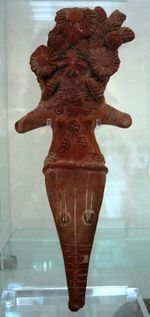
پوشكلڤاتي و پراياگ
تاكسيلا
الحكم الفارسي
الماوريا
اليونانيون-الباكتريون، الساكا والهندو-پارثيون
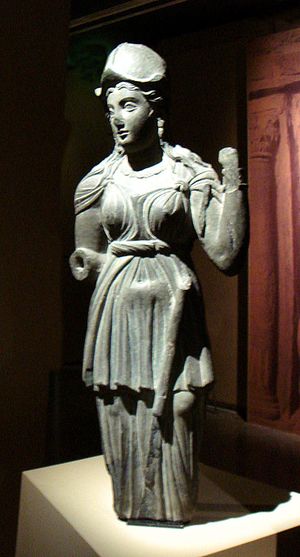
العصر الذهبي للحكم الكوشاني
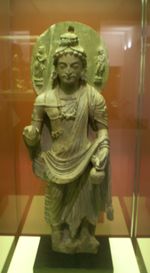

الغزو الهوني

تركيشاهي وهندوشاهي
After the fall of the Sassanid Empire to the Arabs in 644, Afghanistan and Gandhara came under pressure from Muslims. But they failed to extend their empire to Gandhara. Gandhara was first ruled from Kabul and then from Udabhandapura (Hind).
النهاية
Jayapala was the last great king of this dynasty. His empire extended from west of Kabul to the river Sutlej. However, this expansion of Gandhara kingdom coincided with the rise of the powerful Ghaznavid Empire under Sabuktigin. Defeated twice by Sabuktigin and then by Mahmud of Ghazni in the Kabul valley, Jayapala committed suicide. Anandapala, a son of Jayapala, moved his capital near Nandana in the Salt Range. In 1021 the last king of this dynasty, Trilochanapala, was assassinated by his own troops which spelled the end of Gandhara. Subsequently, some Shahi princes moved to Kashmir and became active in local politics.
The city of Kandahar in Afghanistan is said to have been named after Gandhara. According to H.W. Bellow, an emigrant from Gandhara in the 5th century brought this name to modern Kandahar. Faxian reported that the Buddha's alms-bowl existed in Peshawar Valley when he visited around 400 (chapter XII). In 1872 Bellow saw this huge begging bowl (seven feet in diameter) preserved in the shrine of Sultan Wais outside Kandahar. When Olaf Caroe wrote his book in 1958 (Caroe, pp. 170–171), this relic was reported to be at Kabul Museum. The present status of this bowl is unknown.
Al Biruni writing c. 1030 CE, reported on the devastation caused during the conquest of Gandhara and much of northwest India by Mahmud of Ghazni following his defeat of Jayapala at Peshawar in 1001 CE:
"Now in the following times no Muslim conqueror passed beyond the frontier of Kâbul and the river Sindh until the days of the Turks, when they seized the power in Ghazna under the Sâmânî dynasty, and the supreme power fell to the lot of Nâṣir-addaula Sabuktagin. This prince chose the holy war as his calling, and therefore called himself al-Ghâzî ("the warrior/invader"). In the interest of his successors he constructed, in order to weaken the Indian frontier, those roads on which afterwards his son Yamin-addaula Maḥmûd marched into India during a period of thirty years and more. God be merciful to both father and son ! Maḥmûd utterly ruined the prosperity of the country, and performed there wonderful exploits, by which the Hindus became like atoms of dust scattered in all directions, and like a tale of old in the mouth of the people. Their scattered remains cherish, of course, the most inveterate aversion towards all Muslims. This is the reason, too, why Hindu sciences have retired far away from those parts of the country conquered by us, and have fled to places which our hand cannot yet reach, to Kashmir, Benares, and other places. And there the antagonism between them and all foreigners receives more and more nourishment both from political and religious sources."[5]
During the closing years of the tenth and the early years of the succeeding century of our era, محمود الغزنوي the first Sultan and Musalman of the Turk dynasty of kings who ruled at Ghazni, made a succession of inroads twelve or fourteen in number, into Gandhar – the present Peshwar valley – in the course of his proselytizing invasions of Hindustan.[6]
النار والسيف، الاضطراب والدمار، ميزوا مسيرته أينما حل. Gandhar which was styled the Garden of the North was left at his death a weird and desolate waste. Its rich fields and fruitful gardens, together with the canal which watered them (the course of which is still partially traceable in the western part of the plain), had all disappeared. Its numerous stone built cities, monasteries, and topes with their valuable and revered monuments and sculptures, were sacked, fired, razed to the ground, and utterly destroyed as habitations. [6]
اعادة الاكتشاف
By the time Gandhara had been absorbed into the empire of Mahmud of Ghazni, Buddhist buildings were already in ruins and Gandhara art had been forgotten. After Al-Biruni, the Kashmiri writer Kalhaṇa wrote his book Rajatarangini in 1151. He recorded some events that took place in Gandhara, and gave details about its last royal dynasty and capital Udabhandapura.
اللغة
التبشير
Gandharan Buddhist missionaries were active, with other monks from Central Asia, from the 2nd century AD in Han-dynasty (202 BC – 220 AD) China's capital of Luoyang, and particularly distinguished themselves by their translation work. They promoted scriptures from Early Buddhist schools as well as those from the Mahayana.
- Lokaksema, a Kushan and the first to translate Mahayana scriptures into Chinese (167–186)
- Zhi Yao (c. 185), a Kushan monk, second generation of translators after Lokaksema
- Zhi Qian (220–252), a Kushan monk whose grandfather had settled in China during 168–190
- Zhi Yueh (c. 230), a Kushan monk who worked at Nanjing
- Dharmaraksa (265–313), a Kushan whose family had lived for generations at Dunhuang
- Jnanagupta (561–592), a monk and translator from Gandhara
- Shikshananda (652–710), a monk and translator from Udyana, Gandhara
- Prajna (c. 810), a monk and translator from Kabul, who educated the Japanese Kūkai in Sanskrit texts
الفن
كان الاسكندر المقدوني غزا تلك البلاد عام 327 ق.م.، ومع أن اليونانيين لم يمكثوا فيها مدة طويلة؛ إلا أن الغزو المقدوني كان مقدمة لصلات ثقافية استمرت طويلاً بين الهند والأقطار التي تأثرت فنياً بالمدرسة اليونانية الكلاسيكية، وترى في الإنسان مقياس المقاييس الجمالية، فليس هناك أجمل من الإنسان ولا أذكى من عقله ولا أمهر من يديه مما جعل الفنانين يعدون الجسم الإنساني من أهم وسائل التعبير الفني والروحي معاً.
تجلى هذا كله في الفن البوذي في گندهارا التي عالج فيها الفنان البوذي روائعه الفنية متأثراً بالكلاسيكية classicisme وجمالياتها.
وبعد ما كان الفنانون البوذيون في المرحلة الأولى من مراحل تاريخ الفن البوذي الهندي (من القرن الثالث قبل الميلاد حتى القرن الأول الميلادي) في بلاد حوض الغانج، وفي عهود سلالة موريا وسونجا يبنون المباني التذكارية ويبشِّرون بولادة بوذا، وذلك بتصوير حلم أمه «مايا» وهي تبدو مضطجعة نائمة وإلى جانبها فيل كبير أبيض اللون، وبأنها ستلد مولوداً عظيماً وكبيراً كالفيل؛ راح الفنان الهندي في منطقة گندهارا يُقدِم للمرة الأولى على تمثيل بوذا شخصياً متأثراً بالفن اليوناني وجماليته الكلاسيكية.
وهكذا ساد الفن الهندي البوذي طابع إنساني خاص، وظهرت تفصيلات فنية جميلة خاصة كحركة اليدين، والرداء الذي يغطي جسم بوذا ويلتصق به مشكلاً ثنيات عديدة متوازية جميلة التكوين والتشكيل. ويعد تمثال «بوذا جالساً» المحفوظ في متحف جامعة ييل الأمريكية نموذجاً رائعاً لفن النحت البوذي الهندي في منطقة گندهارا.
وثمة تماثيل كثيرة لـ «بوذا واقفاً» بردائه المزين بالثنيات، ويعد تمثال الفتى المزين بالورود المكتشف في هدّا Hadda والمحفوظ في متحف گيمه Guimet في باريس أجمل نموذج يجمع بين جمالية الفن الهندي والفن الهلنستي في گندهارا في بداية القرن الأول الميلادي. وقد أدرك الفنان المبدع جمالية النحت بالإضاءة الموزعة على سطح التمثال وحسن الاهتمام بملامح الوجه والشعر الأجعد.
تطور الفن الهندي البوذي في شمال غربي الهند في غاندارا والولايات الواقعة على تخوم إيران في ولاية بيشاور الباكستانية، وفي كابيسا Kapisa في أفغانستان، ومواقع تنقيبات أثرية في كل من هدّا وباميان Bamyan حيث عثر على آثار تعود إلى عهد سلالة كوشانا Kushana متأثرة بالفن اليوناني، وقد عُرف هذا الفن باسم الفن اليوناني البوذي، وهو يجمع بين روحانية الفن البوذي الهندي وجمالية التشكيل الفني اليوناني الهلنستي.
وهناك منحوتات كثيرة من النضيد schiste الأزرق والجص كانت تزين أديرة هدّا يظهر فيها بوذا للمرة الأولى متدثراً برداء ملتصق بجسمه له ثنيات جميلة تبدو كأنها مبللة وذلك على الطريقة اليونانية، ويبدو بوذا في أوضاع مختلفة ذات دلالات رمزية أسهمت في إثراء علم صور الفن البوذي الهندي؛ فالوجه له طابع مثالي كأنه نموذج الرب اليوناني أبولون Apollon مرسوم ببعض عناصر الفن الهندي مثل شحمة الأذن المتطاولة، ودائرة صغيرة بين الحاجبين، وتحوُّل ضفيرة الشعر إلى نتوء في الجمجمة.
وبالمقابل فقد ظهرت مع الفن اليوناني البوذي جمالية الطبيعة المحلية متأخرة ونمت في القرن الأول حتى القرن الثالث الميلادي بطراز ماتورا Mathura ـ أو فن ما قبل گوپتا Gupta.
وفي مناطق ديكان Dekhan في أماراڤاتي Amaravati الواقعة في وادي كريشنا في جنوبي الهند؛ ظهر بين القرنين الأول والرابع الميلاديين أسلوب فني نحتي فقد ثقله الطبيعي المحلي بتأثير الفن اليوناني البوذي فتميز بالبحث عن التعبير بالحركة، وبالوجوه المتطاولة وبانحناءة طقسية لطيفة للجسم ظهرت في عصر سانشي.
في القرن الثالث الميلادي امتزج فن گندهارا بفن ماتورا الهندي الصافي الذي قدم بوذا بخصره النحيل وكتفيه العريضتين، وقد تدثر برداء شفاف، فكوَّن الاثنان معاً فناً يجمع بين الاتجاه الرمزي الذي يؤكد الجانب الروحي في العقيدة، والاتجاه الحسي الجمالي الذي يعبر عن حب الحياة والتفاعل معها، ويقترب في الوقت ذاته من الفن الهندوكي (الهندوسي) التقليدي، واستمر ازدهار هذا الفن حتى القرن الخامس عشر الميلادي حين قضت عليه غزوات قبائل الرعاة الهون Huns.
الإلهة الأم (إلهة الخصوبة)، مشتقة من تقليد وادي السند، terracotta, Sar Dheri، گندهارا (القرن 1 ق.م.)
بوذا في acanthus capital
The Bodhisattva Maitreya (القرن 2)
Wine-drinking and music, Hadda (القرن 1-2)
The Buddha preaching at the Deer Park in Sarnath (القرن 2-3)
The death of the Buddha, or parinirvana (القرن 2-3)
The Bodhisattva and Chandeka, Hadda (القرن 5)
Hellenistic decorative scrolls from Hadda، شمال پاكستان
الخط الزمني
- Legend: Bharat, the brother of Lord Rama of Kosala, ruled from Gandhara, his sons were Taksh and Pushkala, who inhabited new cities called Taksha-shila (Taxila), and Pushkarvati (پشاور).[7] Tentative timeline for this event is 5000 B.C. or before that.
- ح.2300–ح.1900 ق.م. حضارة وادي السند
- c.1900–c.520 BC No records. Indo-Aryan migrations. Ramayana legend says Lord Rama's brother Bharat ruled from Gandhara.
- c.520–c.326 BC Persian Empire Under direct Persian control and/or local control under Persian suzerainty.
- c.326–c.305 BC Occupied by Alexander the Great and Macedonian generals
- c.305–c.180 BC Controlled by the Maurya dynasty, founded by Chandragupta. تحولت إلى البوذية في عهد الملك أسوكا (273–232 ق.م.)
- ح.185–ح.97 BC Under control of the المملكة الهندو-يونانية, with some incursions of the Indo-Scythians from around 100 BC
- ح.97 ق.م.–ح. 7م حكم ساكا (السكوذي)
- c.07–c.75 Parthian invasion and المملكة الهندو-يونانية, Rule of Commander Aspavarman?. Ambhi Kumar, ملك گندهارا كان سليل الإله راغو والأمير بهارات من مملكة كوسالا.
- ح.75–ح.230 امبراطورية كوشان
- c.230–c.440 Kushanshas under Persian Sassanid suzerainty
- ح.450–ح.565 الهون البيض (الهفتاليون)
- c.565–c.644 Nezak kingdom, ruled from Kapisa and Udabhandapura
- c.650–c.870 Turkshahi, ruled from Kabul
- ح.870–1021 هندوشاهي, ruled from Udabhandapura
- ح.1032–1350 Conquered and controlled by the امبراطورية محمود الغزنوي.
انظر أيضاً
المصادر
- بشير زهدي. "غاندارا". الموسوعة العربية.
الهامش
- ^ من السنسكريتية puruṣa= (primordial) إنسان و pura=مدينة
- ^ Encyclopædia Britannica: Gandhara
- ^ كالهانا راجاترنگيني أشار إليهم ببساطة بكلمة شاهي وذكرتهم النقوش بكلمة ساهي.(Wink, pg 125)
- ^ أشار البيروني إلى الحكام المتعاقبين بمصطلح "الملوك البراهمة" إلا أن معظم المراجع الأخرى مثل كلهان تشير إليهم بكلمة كشاتريا. (Wink, pg 125)
- ^ Alberuni's India. (c. 1030 CE). Translated and annotated by Edward C. Sachau in two volumes. Kegana Paul, Trench, Trübner, London. (1910). Vol. I, p. 22.
- ^ أ ب The races of Afghanistan Being a brief account of the principal nations inhabiting that country By Henry Walter Bellow Asian Educational services Page 73
- ^ Vālmīki, "Ramayana, the epic of Rama, prince of India", page 181
المراجع
- Beal, Samuel. 1884. Si-Yu-Ki: Buddhist Records of the Western World, by Hiuen Tsiang. 2 vols. Trans. by Samuel Beal. London. Reprint: Delhi. Oriental Books Reprint Corporation. 1969.
- Beal, Samuel. 1911. The Life of Hiuen-Tsiang by the Shaman Hwui Li, with an Introduction containing an account of the Works of I-Tsing. Trans. by Samuel Beal. London. 1911. Reprint: Munshiram Manoharlal, New Delhi. 1973.
- Bellew, H.W. Kashmir and Kashgar. London, 1875. Reprint: Sang-e-Meel Publications 1999 ISBN 969350738X
- Caroe, Sir Olaf, The Pathans, Oxford University Press, Karachi, 1958.
- Herodotous, The Histories, Translated by Aubrey De Selincourt, Penguin Books, 1954.
- Hill, John E. 2003. "Annotated Translation of the Chapter on the Western Regions according to the Hou Hanshu". 2nd Edition.
- Hussain, J. An Illustrated History of Pakistan, Oxford University Press, Karachi, 1983.
- Legge, James. Trans. and ed. 1886. A Record of Buddhistic Kingdoms: being an account by the Chinese monk Fâ-hsien of his travels in India and Ceylon (A.D. 399–414) in search of the Buddhist Books of Discipline. Reprint: Dover Publications, New York. 1965.
- Shaw, Isobel. Pakistan Handbook, The Guidebook Co., Hong Kong, 1989
- Watters, Thomas. 1904–5. On Yuan Chwang's Travels in India (A.D. 629–645). Reprint: Mushiram Manoharlal Publishers, New Delhi. 1973.
وصلات خارجية
- Articles containing سنسكريتية-language text
- Articles containing Pashto-language text
- Pages using Lang-xx templates
- Articles containing أردو-language text
- Articles containing إنگليزية-language text
- Articles with hatnote templates targeting a nonexistent page
- گندهارا
- Pre-Islamic history of Afghanistan
- Empires and kingdoms of Pakistan
- Pre-Islamic heritage of Pakistan
- ساتراپيات أخمينية
- شاهي كابول
- الهند القديمة
- شعوب قديمة
- Mahajanapadas
- حضارات
- Kingdoms in the Ramayana
- مواقع أثرية في پاكستان
- Locations in Hindu mythology
- Khyber Pakhtunkhwa
- Buddhism in Afghanistan
- Hinduism in Afghanistan
- Historical regions of Afghanistan



